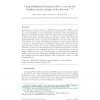Free Online Productivity Tools
i2Speak
i2Symbol
i2OCR
iTex2Img
iWeb2Print
iWeb2Shot
i2Type
iPdf2Split
iPdf2Merge
i2Bopomofo
i2Arabic
i2Style
i2Image
i2PDF
iLatex2Rtf
Sci2ools
ADHOC
2015
2015
Using multiparent routing in RPL to increase the stability and the lifetime of the network
Energy is a very scarce resource in Wireless Sensor Networks. While most of the current proposals focus on minimizing the global energy consumption, we aim here at designing an energy-balancing routing protocol that maximizes the lifetime of the most constraint nodes. To improve the network lifetime, each node should consume the same (minimal) quantity of energy. We propose the Expected Lifetime metric, denoting the residual time of a node (time until the node will run out of energy). We design mechanisms to detect energy-bottleneck nodes and to spread the traffic load uniformly among them. Moreover, we apply this metric to RPL, the de facto routing standard in low-power and lossy networks. In order to avoid instabilities in the network and problems of convergence, we propose here a multipath approach. We exploit the Directed Acyclic Graph (DAG) structure of the routing topology to probabilistically forward the traffic to several parents. Simulations highlight that we improve both the...
| Added | 13 Apr 2016 |
| Updated | 13 Apr 2016 |
| Type | Journal |
| Year | 2015 |
| Where | ADHOC |
| Authors | Oana Iova, Fabrice Theoleyre, Thomas Noël |
Comments (0)

